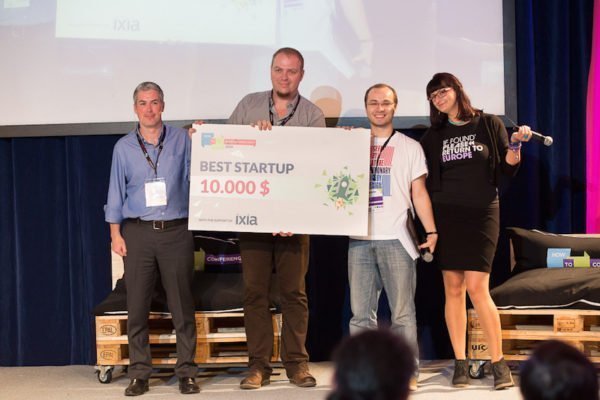
I had the honour of being a mentor at Startup Spotlight, a competition for the most promising CEE startups. Organized in parallel with the 5th edition of Bucharest’s How to Web Conference, Startup Spotlight is the most important innovation, technology and entrepreneurship event in South-Eastern Europe.
For Eastern European entrepreneurs, Startup Spotlight not only offers an opportunity to gain regional and international exposure but also to gain expert advice, connect to early-stage investors and meet potential strategic partners and advisors. The impressive success rate of the program speaks for itself: 35% of participants secure an investment, establish a strategic partnership, or are admitted to an accelerator program as a direct result of participating.
In 2014, How to Web Startup Spotlight brought together 31 teams from 10 countries in Central and Eastern Europe, with the winners receiving $25,000 worth of cash prizes provided by IXIA, the program’s main partner.
Axo Suits wins The Best Startup award with a Romanian exoskeleton

The Best Startup and winner of $10,000 was Axo Suits, a Romanian medical technology company that manufactures high-powered exoskeletons that can be used to increase the quality of life for paraplegics, the elderly, and patients with short-term disabilities. Although the technology itself isn’t new, Axo Suits stands out from competitors like ReWalk, Ekso Bionics and Cyberdyne because their product is more accessible and is integrated into the ecosystem of smart devices.
“We took a 50-year-old idea and reshaped it into an affordable device desperately needed by the cash-strapped healthcare industry. The larger players have a prohibitively high pricing strategy while some even have usability issues. The yearly production is in the hundreds range while the demand is over 10 million in the developed markets alone. Axo Suits reached a working prototype phase in less than 18 months with very low costs. We’re a private venture with no government or academic funding. The reason for our agile development is the fact that we created our own smart software and intelligent design. We also made use of medical-grade COTS components. The combination of ingenuity and a no-frills approach, enabled us to create a high-powered medical exoskeleton which costs no more than a medium-sized car,” said Axo Suits founder Andras Kapy.
Last month Axo Suits won the first local edition of Get In The Ring, and has already received the attention of five international investment funds. The Axo Suits team will approach top-level business accelerators like the R/GA Accelerator next year.
As far as the exoskeleton, in general, is concerned, there are plenty of big companies trying to a breakthrough in this market. A brief review you can read here: Panasonic Exoskeleton to be launched in September.
Smart glasses for people with visual disabilities
Taking home the $5,000 IXIA Innovation Award was Project Wipe, a company that created electronic glasses to help people with visual disabilities in orientation and obstacle avoidance. When a good friend lost his vision due to an eye infection, two software engineers and a psychologist from Cluj with strong backgrounds in research and development, decided they should find a way to increase the independence and quality of life for people facing similar challenges. In just one month (July 2014) the team built a test-pad using a 3D sensor that provided the blind with information about the obstacles surrounding them. Their project also benefited from the help of two engineers who specialized in sensor devices, in addition to two independent organizations for the blind from Cluj and Debrecen (Hungary).
The Project Wipe team is now developing its second prototype, a wireless wearable device. According to co-founder Gyorgy Tamas, the device will be similar to a pair of eyeglasses and will leverage the IMU (inertial measurement unit) system. It will detect whether movement directions coincide with eye-movements, therefore avoiding false alarms. This prototype will be ready for patient testing sometime in April 2015.
When looking at other competitors in the market, Tamas says other available devices are still in their early stages. The Oxford Smart Specs Project, funded by NIHR i4i program and Royal Society Brian Mercer Award for Innovation, has developed a pair of smart glasses which can enhance sight for people with very poor vision. The glasses are meant for indoor use and improve night vision.
Healthier employees, happier employers
fittter™ is a health and fitness mobile and web app that aims to decrease health costs by enabling employees to incorporate healthy habits into their daily routine. By connecting employees with handpicked health coaches via the app, and providing them with the tools to incorporate new healthy habits into their lives fittter™ aims to decrease healthcare spending.
How does fittter™ work? After you’ve created a personal profile, you can pick the coach of your choice. The app suggests a trainer for you by matching their expertise to your personal goals. Certified coaches are carefully selected and tested beforehand, ensuring the highest quality advice in addition to bespoke content. Following a detailed evaluation by your coach, a personalized health plan is developed, that covers workouts and complimentary advice. You’re able to perform your workouts anywhere while logging your progress. This way both you and your coach can track your progress over time and adjust your workouts accordingly. By collapsing all communications into one place, fittter™ ensures a seamless training experience and enables you to stay motivated and achieve your goals.
The team has developed a pilot program with Camp Gladiator and has joined Health Wildcatters, a Dallas healthcare startup accelerator, hoping to raise $650k in seed capital.
Conclusion
Although predictions for a fast-changing marketplace are hard to make, Silicon Valley Bank research believes that the next few years should continue to provide solid returns to venture healthcare investors. Here are three reasons why:
- For the past three years healthcare venture fundraising has exceeded $3.5B annually; a healthy level for innovation;
- More than half of these new investments were in pre-clinical or Phase I companies, another positive sign from investors;
- According to a new market report published by Transparency Market Research, the medical wearable device market is expected to reach a value of $8 billion by 2019.
As you finish reading this article, 115 dedicated healthcare accelerators currently exist worldwide, and this figure doesn’t include technology accelerators that often accept healthcare tech companies. With this in mind, I look forward to seeing more incredible growth within this market in South-Eastern Europe and across the globe.
*This story was first published on R/GA blog.



